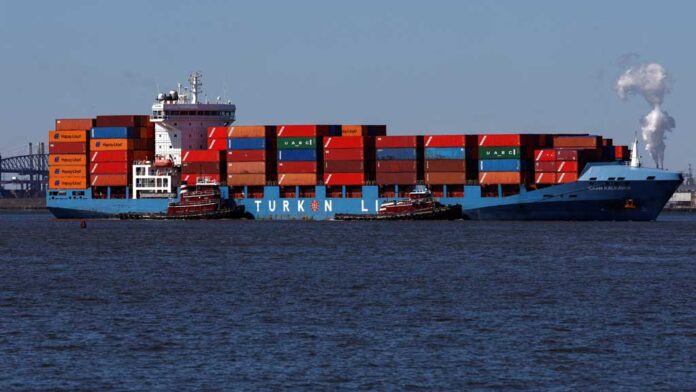In a dramatic reversal, U.S. President Donald Trump announced that he would temporarily ease the steep tariffs he had just imposed on multiple countries while simultaneously increasing pressure on China, triggering a surge in global stock markets.
Trump’s unexpected shift on Wednesday came less than a day after his sweeping new tariffs took effect on most trading partners. His decision followed the most severe bout of financial market volatility since the early days of the COVID-19 pandemic, which erased trillions of dollars from stock markets and caused a sharp rise in U.S. government bond yields—factors that seemingly influenced Trump’s decision.
“I thought people were getting a little too excited, you know, a bit yippy,” Trump told reporters, using a golf term to describe the market reaction.
Since his return to the White House in January, Trump has repeatedly threatened severe trade penalties on various countries, only to withdraw some at the last moment. This unpredictable approach has confounded global leaders and unsettled business executives, who say the uncertainty makes market forecasting increasingly difficult.
The day’s developments underscored the lack of clarity surrounding Trump’s trade policies and the decision-making process within his administration.
U.S. Treasury Secretary Scott Bessent defended the policy shift, claiming that the pullback had always been part of a broader strategy to bring countries to the negotiating table. However, Trump later suggested that the market turmoil following his April 2 tariff announcement had played a role in his decision.
Despite repeatedly insisting that his policies were set in stone, Trump told reporters on Wednesday, “You have to be flexible.”
Still, he maintained his hardline stance on China, the second-largest supplier of U.S. imports. Trump announced that tariffs on Chinese goods would be raised to 125%—up from the 104% rate that took effect at midnight—escalating tensions between the world’s two largest economies, which have been locked in a cycle of retaliatory tariffs over the past week.
Trump’s reversal on tariffs for other nations was not absolute. A 10% across-the-board duty on nearly all U.S. imports will remain in effect, according to the White House. The announcement also left existing tariffs on autos, steel, and aluminum unchanged.
Furthermore, the 90-day freeze does not apply to tariffs on Canada and Mexico, as their exports remain subject to a 25% fentanyl-related duty unless they fully comply with the U.S.-Mexico-Canada trade agreement’s rules of origin. However, an indefinite exemption was granted for goods meeting USMCA requirements.
“China is unlikely to change its strategy: stand firm, absorb pressure, and let Trump overplay his hand,” said Daniel Russel, Vice President for International Security and Diplomacy at the Asia Society Policy Institute. “Beijing believes Trump views concessions as weakness, so any sign of retreat could invite more pressure.”
Russel added that while other nations may welcome the 90-day pause, the ongoing policy shifts “only add to the uncertainty that businesses and governments hate.”
Financial markets reacted sharply to Trump’s announcement. The S&P 500 surged 9.5%, while bond yields pulled back from recent highs, and the U.S. dollar regained ground against safe-haven currencies. Asian markets followed suit, with Japan’s Nikkei soaring nearly 9% on Thursday morning.
The relief rally came after Trump’s tariffs triggered a multi-day market selloff, wiping out trillions of dollars in value and destabilizing U.S. Treasury bonds and the dollar—the foundation of the global financial system. Canada and Japan stated they were prepared to intervene if necessary, a role the U.S. traditionally plays during economic crises.
However, analysts warned that the market rebound might not erase all economic damage. Business investment and consumer spending have slowed due to concerns over the tariffs’ impact, and a Reuters/Ipsos poll found that three in four Americans expect prices to rise in the coming months.
Goldman Sachs revised its recession probability down from 65% to 45% following Trump’s move but noted that the remaining tariffs could still lead to an overall 15% increase in the U.S. tariff rate.
Bessent dismissed concerns about the market turmoil, insisting the reversal rewarded countries that had refrained from retaliating. He suggested Trump had used the tariffs as a strategic bargaining tool.
“This was his strategy all along,” Bessent told reporters. “You could even argue that he maneuvered China into a tough position.”
As the lead negotiator in trade talks, Bessent is handling discussions that could include foreign aid and military cooperation, in addition to economic matters. The White House confirmed that Trump had spoken with the leaders of Japan and South Korea, while a Vietnamese delegation met U.S. officials on Wednesday to discuss trade issues.
Bessent declined to specify how long negotiations with more than 75 countries that had reached out would take.
Trump also suggested that an agreement with China was possible, though officials indicated that talks with other nations would take priority.
“China wants to make a deal,” Trump said. “They just don’t know quite how to go about it.”
He claimed he had been considering the tariff pause for several days. Notably, on Monday, the White House dismissed reports of a potential shift in policy as “fake news.”
Before Wednesday’s announcement, Trump attempted to calm investors with a post on Truth Social: “BE COOL! Everything is going to work out well. The USA will be bigger and better than ever before!”
Later, he added: “THIS IS A GREAT TIME TO BUY!!!”



